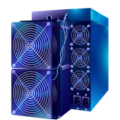Asic Miner Profitability
Our mining profitability calculator helps users quickly pinpoint the most lucrative mining options by delivering real-time data in multiple fiat and cryptocurrency currencies, including USD, EUR, GBP, AED, CAD, AUD, THB, ETH, and BTC. It allows precise electricity cost inputs up to three decimal places for highly accurate profit estimations. Users can access a clear overview of top-performing miners, algorithm-specific performance tables, and visually organized listings of mineable coins with recognizable cryptocurrency icons, simplifying decisions for maximum returns.
| Model | Hashrate |
Profitability
Profit
|
|---|---|---|
|
Jasminer X44-P
23.4GH/s
|
23.4 GH/s |
$11.57/day
|
|
Bombax EZ100 PRO
15.5GH/s
|
15.5 GH/s |
$4.95/day
|
|
Bombax EZ100
12.5GH/s
|
12.5 GH/s |
$4.38/day
|
|
IPollo V2
10GH/s
|
10 GH/s |
$4.16/day
|
|
Bitmain Antminer E11
9.5GH/s
|
9.5 GH/s |
$1.94/day
|
|
Bitmain Antminer E11
9GH/s
|
9 GH/s |
$1.84/day
|
|
IPollo V2H
3.4GH/s
|
3.4 GH/s |
$1.48/day
|
|
Bombax EZ 100
3800MH/s
|
3800 MH/s |
$1.21/day
|
|
Bombax Miner EZ100-C
3800MH/s
|
3800 MH/s |
$1.21/day
|
|
IPollo V2X
1.2GH/s
|
1.2 GH/s |
$0.53/day
|
|
Jasminer X16-P
5.8GH/s
|
5.8 GH/s |
$0.43/day
|
|
Jasminer X16-Q PRO - 8GB
2050MH/s
|
2050 MH/s |
$0.39/day
|
|
Jasminer X16-QE - 6GB
1750MH/s
|
1750 MH/s |
$0.23/day
|
|
Jasminer X16-Q Jasminer
1.95GH/s
|
1.95 GH/s |
$0.18/day
|
|
Jasminer X4 BRICK
65MH/s
|
65 MH/s |
$-0.01/day
|
Our cutting-edge mining calculator offers comprehensive insights across all major cryptocurrency algorithms, helping users easily identify the most profitable options for their specific hardware. The algorithm data is continuously refreshed to keep pace with the dynamic crypto mining industry, providing accurate evaluations based on real-time profitability statistics and overall market activity. This empowers users to make well-informed choices that reflect the latest mining conditions and algorithm performance.
Bitcoin Mining Difficulty
Monitor the latest Bitcoin network difficulty metrics in real time, including block times & estimated time until the next difficulty adjustment.
Progress
Current progress:
61.51 %
Remaining Block
Blocks Left:
776
Remaining Time
Time Left:
~ 5 days 1 hours
Next Change
Upcoming change:
6.9 %
Block Time
Current Block Time:
9.4 minutes
What is Etchash algorithm?
Why Should You Rely on Our Profit Calculator for Accurate Mining Insights?
Etchash moves like a disciplined swarm through silicon corridors, a memory-hard Proof of Work designed for Ethereum Classic that keeps GPU miners alive and in step. It arrived in November 2020 with the Thanos Upgrade under ECIP-1099, which reset and slowed the DAG so rigs with 3GB and 4GB of VRAM could rejoin the hunt. The algorithm is a deliberate evolution of Ethash and keeps the high memory bandwidth focus that forces work to live in VRAM rather than in custom logic. It changes the epoch schedule to slow dataset expansion and stretch hardware lifespans. This shift reduces forced upgrades and steadies participation across mid-tier and older GPUs. The DAG and cache remain central as the engine that drives pseudo-random memory access and throttles compute-heavy tricks. That design resists ASIC dominance and blunts the influence of hash power rental services, raising the effort required to stage a coordinated attack. More accessible mining deepens the pool of independent operators and lifts the cost of 51% attacks through broader distribution of hashrate. Etchash preserves the familiar workflow for Ethash miners yet lowers the resource gradient so entry remains practical. It has been picked up by some forks, including EthereumPoW, which anchors it within the wider Ethash family. Miners watch VRAM headroom and memory bandwidth because those factors shape hashrate more than raw core clocks. Stable drivers, tuned memory timings, and up-to-date mining software help maintain efficiency as epochs advance. The slower DAG growth extends the useful life of 4GB cards far beyond what the original Ethash allowed. This keeps the network defended by many hands instead of a few machine lords. Profitability can be gauged with a miner calculator that models hashrate, power draw, and difficulty over time. In practice the chain feels like a guarded city where each block is a gate and every GPU is a sentinel that refuses to stop shuffling forward.
Latest ASIC Miners
Check out the latest ASIC miners added to our site. These are the newest listings, featuring the most recent models.
V3
Nerdminer
AE3
IceRiver
Antminer L11 Hyd 2U
Bitmain
Why ASIC Mining?
The Advantages of ASIC Mining Compared to Other Mining Types
ASIC (Application-Specific Integrated Circuit) mining involves specialized hardware designed exclusively for mining cryptocurrencies like Bitcoin, offering unmatched efficiency and performance. Unlike general-purpose GPUs, ASICs are optimized for specific algorithms, delivering significantly higher hashrates while consuming less power per hash. This makes them far superior for mining tasks, as they maximize profitability by reducing electricity costs and increasing mining output. ASIC miners are purpose-built, providing stability and reliability in high-demand mining environments, unlike GPUs which are prone to overheating and wear during prolonged use. Their compact design also allows for easier scalability in large mining operations. By focusing solely on mining, ASICs eliminate the overhead of multi-purpose computing, resulting in faster block-solving times. This efficiency translates to higher rewards, making ASICs the preferred choice for serious miners aiming to stay competitive in the cryptocurrency market. In contrast, GPU mining, while versatile, cannot match the raw power and cost-effectiveness of ASICs for dedicated mining tasks.
Optimized for Mining
Energy Efficient
Reliable & Stable
Scalable
More about the Etchash algorithm
See how our profit calculator delivers accurate, real-time mining insights, helping miners make informed decisions.
A crucial yet often overlooked feature of Ethash is its epoch-based, dynamic DAG (Directed Acyclic Graph), regenerated every 30,000 blocks-roughly every five days on Ethereum Classic-compelling miners to continually load a multi‑gigabyte dataset derived from block-height seeds; this architecture enforces pseudo-random memory walks driven by Keccak-based mixes and FNV permutations, making memory bandwidth and latency, not raw core frequency, the principal determinants of hashrate, thereby compressing the advantage of specialized ASICs and reinforcing GPU competitiveness as DAG growth pressures low‑VRAM cards and penalizes stagnant hardware. To recalibrate that pressure and broaden participation, Ethereum Classic introduced Etchash in November 2020 via the Thanos Upgrade (ECIP‑1099), reducing the effective DAG size and slowing its growth so that 3 GB and 4 GB GPUs could re-enter the field, a parameter shift that expanded the miner base, diluted single-operator influence, and raised the cost and complexity of renting hash power for short-lived majority attacks; Etchash preserves the Ethash grammar of epochs, light caches, and verifiable mining while lowering resource intensity, and its parameters have informed other projects such as EthereumPoW, anchoring it within the Ethash family. Because the DAG and its light cache are epoch-bound and regenerated from deterministic seeds, large-scale precomputation and simple brute-forcing are uneconomic, and frequent updates discipline hardware rent-seeking by curbing long-duration dominance; in practice, GPUs with high memory throughput, adequate VRAM headroom, and efficient power curves prevail, and tuning favors memory overclocks, core undervolting, and thermal stability, since the algorithm’s randomized access patterns saturate memory interfaces. The net effect is an ASIC-resistant, memory-hard model that constrains the economies of massive farms, distributes mining more evenly, and hardens validation against tampering-an engineered equilibrium where modern computation and a measured touch of alchemy keep time together.
 English
English
 German
German
 Hungarian
Hungarian
 Dutch
Dutch
 Spanish
Spanish
 French
French
 Italian
Italian
 Czech
Czech
 Polish
Polish
 Greek
Greek



















